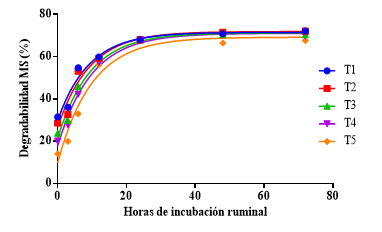Effect of the inclusion of banana peel on the in situ degradability of forage corn silage
Efecto de inclusión de cáscara de plátano en la degradabilidad in situ de ensilaje de maíz forrajero
Show authors biography
Objective. To determine the ruminal degradability in situ of the forage corn silage with inclusion levels of banana peel. Materials and methods. The Treatments were: T1 = 100% forage corn; T2 = 75% corn forage with 25% banana peel; T3 = 50% corn forage with 50% banana peel; T4 = 25% corn forage with 75% banana peel and T5 = 100% banana peel. Stored for 30 days in PVC tubes with a capacity of three kilograms. A randomized complete block design was applied with five treatments and three bovines with fistulated rumen and seven incubation times (0, 3, 6, 12, 24, 48 and 72 hours). The differences between treatment means were established using the Tukey test (p <0.05). The ruminal degradability in situ of the dry matter of the forage corn silage including banana peel was accepted up to 25% inclusion of banana peel, that is, 75% fodder corn + 25% banana peel. Results. The ruminal degradability in situ of the organic matter of the forage corn silage with banana peel was notorious with similar content in all treatments. The inclusion levels of banana peel, showed greater disappearance of dry matter and organic matter when including up to 25% of banana peel in the forage corn silage (T1 and T2), presenting an improvement in the microbial population and therefore a better ruminal environment, which facilitates the colonization of the substrate used. Conclusions. The inclusion levels of banana peel (Musa balbisiana), showed the greatest disappearance of dry matter and organic matter when including up to 25% of banana peel in the silage based on forage corn.
Keywords: fermentation, digestibility, agricultural residues.
Article visits 531 | PDF visits




